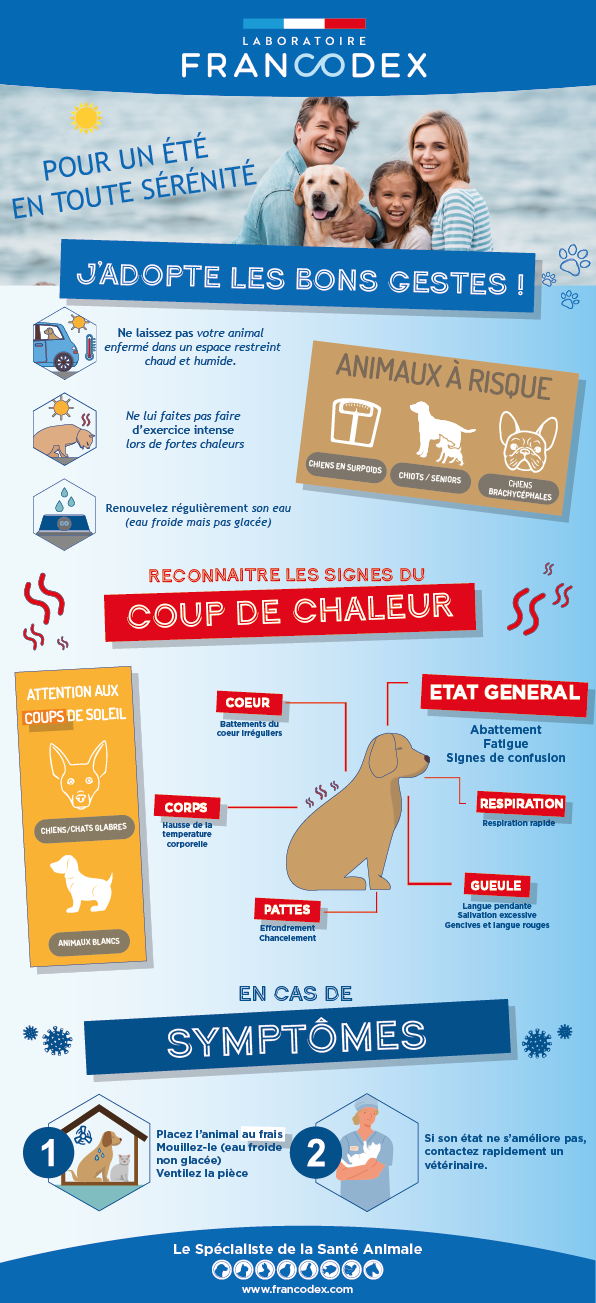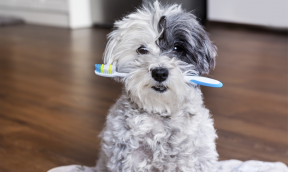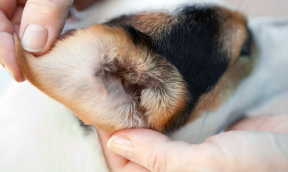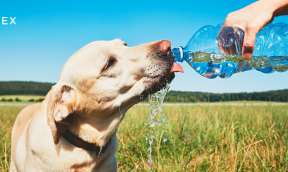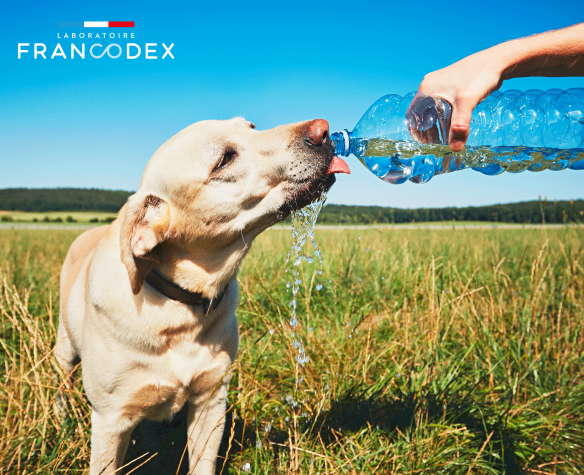
Summer heat: how can you keep your dog cool and ensure its well-being?
Contents: Why can summer be a dangerous time of year for a dog? | How can you tell if your dog is too hot? | What are the best ways to care for your dog in summer? | How can you keep your dog cool without damaging its health? | What other sources of stress can dogs experience in summer?
 Summer’s here and your dog is less excited than you about the return of the long, sunny, sometimes scorching days. Pets are vulnerable during the summer months, as they struggle to regulate their internal temperature and their health can suffer as a result. Here Francodex gives you a few tips on how to care for your dog and keep it cool for a trouble-free summer!
Summer’s here and your dog is less excited than you about the return of the long, sunny, sometimes scorching days. Pets are vulnerable during the summer months, as they struggle to regulate their internal temperature and their health can suffer as a result. Here Francodex gives you a few tips on how to care for your dog and keep it cool for a trouble-free summer!
Why can summer be a dangerous time for a dog?
You may love sunbathing in the middle of August, but your dog doesn’t share your passion! Pets suffer from the heat as soon as the thermometer registers 20 to 25°C. Wind and humidity levels can affect the way temperatures feel, but on the whole your pet will not appreciate the heat.
Depending on the breed, the animal’s age and its state of health, your dog will suffer from high temperatures to a greater or lesser extent.
Because dogs have few sweat glands, they have difficulty regulating their body temperature and removing heat from their bodies. This makes them vulnerable as soon as the mercury rises.
🐕 Where are a dog’s sweat glands located? A dog’s sweat glands are located underneath the paws between the pads. As this surface area is relatively small, the little perspiration that is produced does not allow optimum regulation of its internal temperature. Your pet gets hot very quickly and you need to help it cool down.
How can you tell if your dog is too hot?
If your dog is too hot, it will start panting. This is the first sign of discomfort in a dog that finds itself in an environment that is too hot or poorly ventilated.
🐕 My dog is panting when it's really not hot, is this normal? Your dog’s perception of temperatures differs from yours. Bear in mind that, compared with you, your pet is nearer the ground. In summer, asphalt can reach 50°C when the temperature is just 40°C at a height of 1 or 2 metres. Similarly, the ground can become white hot during a heatwave, reaching up to 60°C! However, a dog may indeed pant for other reasons: fear, illness, stress, etc.
Your dog is panting. If nothing is done to make it more comfortable, it may start to breathe more quickly. It will look nervous, move around a lot and may also yawn repeatedly.
If the situation is not quickly taken seriously, it may start vomiting. Its tongue can even turn blue if it is not sufficiently oxygenated (the naturally bluish tongue of Chow Chows and Shar-Peis is an exception!).
Don't wait for your pet's discomfort to become generalised and for multiple signs of suffering to appear. Here we explain how to cool a dog down so it has a pleasant summer.
🐶 Never leave a dog alone in a car! Animal protection associations repeat this advice year after year, but never leave your dog alone in a car! Even if the window is open, even if you’ve left the ignition and air conditioning on, even if you’ll only be gone for a few minutes! At the height of summer, the interior of a car can reach 70°C in just a few minutes, and your pet can die in 30 minutes.
What are the best ways to care for your dog this summer?
Summer is a difficult time for vulnerable people and for animals. Even though it’s the season for holidays and fun, you need to remain vigilant to ensure your companion’s well-being. Here are a few tips on how to keep your dog cool when it’s very hot or there’s a heatwave.
Water, water and more cool water!
Offer unlimited fresh water now more than ever! In summer, your pet drinks more. So make sure their water bowl is always full.
If you’re going to be away for a few hours, add a second bowl of water just in case.
You should also remember to replace the water more often, as in summer the water quickly becomes stagnant.
In addition, place your pet’s water container indoors to avoid attracting mosquitoes.
Water-rich food
Opt for walks when it’s cooler, either early in the morning or late at night. During the day, take your dog out to relieve itself and stretch its legs, but no more than that.
Make sure you stay on a shady pavement to prevent their paw pads from suffering on the hot ground. If possible, try and walk where there’s some greenery. Apply a paw balm to alleviate asphalt burns if, despite your precautions, your pet has been burned.
Summer is not the season for great performances. Is your dog dragging its feet? Go home and make the most of the indoor cool by closing your shutters or curtains!
Water games for a cooler summer
Take your dog out by the water more and more during the summer. Some dogs like water more than others, but they all enjoy cooling off for a few minutes in a pool, a lake or by the sea.
You can also moisten your pet with a damp towel, a spray bottle or refreshing wipes several times a day.
On summer outings, we recommend that you take a first-aid kit with you, so that you can quickly attend to any minor problems. Your pet may suffer from the heat, but it could also slip at the water's edge and injure itself.
A cool, shady place to rest
Prepare a resting place for your dog in a shady, well-ventilated area of your home, so that it can rest in good conditions both day and night.
If your naturally playful dog spends its summer days sleeping, it isn’t anything to worry about. It’s conserving its energy and trying not to make its body temperature rise in unfavourable conditions.
🥶 Can I cool my dog down with a fan or air conditioning? We advise against exposing your dog to draughts, or placing them right next to a fan or air conditioning outlet. Cold draughts are bad for your pet. You can ventilate or air-condition a room, but your pet will need to enjoy the benefits of this cooling effect indirectly.
Refreshing treats
Offer refreshing treats - they are very popular with dogs in summer. You can give one to your pet once a day.
You can buy ice cream for dogs, but ice cubes may be all your dog needs. You can also freeze chicken stock ice cubes for a delicious and refreshing treat. Be careful, however, not to give them out fresh from the freezer: have you ever noticed that when an ice cream is too cold, it sticks to something warmer? Imagine if this happened to your dog’s tongue! To avoid this, you should wait a few minutes before giving your dog frozen food or ice cubes. What’s more, if it’s too cold, it can affect the digestion of more sensitive animals.
✂️ Should you cut your dog’s long hair in summer? A dog’s coat protects it from the cold and from overheating. It also protects its skin from sunburn. For summer, depending on the breed, you may opt for a shorter cut, but never shave your dog, as this would make it more vulnerable to the sun's rays. Likewise, leave a small protective layer of hair on its belly and chest to protect it from the hot ground.
How can you keep your dog cool without damaging its health?
As we’ve just seen, it’s vital you keep your pet cool during the summer, but you must be careful not to cause it even more discomfort.
Here are a few precautions you can take to ensure your pet’s well-being:
-Avoid cold floors, freezing showers and draughts. Dogs don’t like this kind of thing, especially those who often suffer from osteoarthritis and stiffen up more quickly.
-Don’t leave your dog in the sun if they’re wet, as their skin will be less protected by their coat and they might get sunburn.
-Keep an eye on how long your dog spends in the water, as your pet is at risk of water poisoning if it swallows too much salt water or fresh water.
-Avoid letting them swim in watercourses where the flow of water is very low, or where shallow natural pools form. These are veritable breeding grounds for bacteria that can make dogs and their humans very ill.
What are the other sources of summer stress for dogs?
Summer is a time when fleas, tics and other external parasites proliferate. Treat your pet against these pests, which invade planted areas as soon as the mercury rises.
If you live in a region where the risk of infestation is low, or if your pet does not go out much, opt for a plant-based repellent. If your pet spends a lot of time outdoors, choose a treatment designed for use in summer. Always keep a dog and cat tick remover close at hand!
Going on holiday with your dog? It should be a shared pleasure - but the change of environment can make it stressful. We recommend that you put a valerian-based calming collar on your pet to ensure that this unusual time goes as smoothly as possible.
Summer is also a season of fireworks and thunderstorms. To calm your pet, opt for anti-stress pipettes with valerian extracts or anti-stress treats with camomile and lemon balm extracts. Above all, keep your pets away from noises that terrify them!
Now you’re ready to have a great summer with your pet!
Article written with the assistance of
Dr Stéphanie Padiolleau, veterinary surgeon
